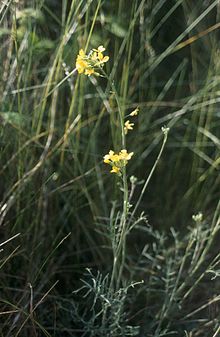Manx is an adjective describing things or people related to the Isle of Man:

The golden samphire is a perennial coastal species, which may be found growing on salt marsh or sea cliffs across western and southern Europe and the Mediterranean.

Primula vulgaris, the common primrose, is a species of flowering plant in the family Primulaceae, native to western and southern Europe, northwest Africa, and parts of southwest Asia. The common name is primrose, or occasionally common primrose or English primrose to distinguish it from other Primula species also called primroses. None of these are closely related to the evening primroses.

Anacamptis morio, the green-winged orchid or green-veined orchid, is a flowering plant of the orchid family, Orchidaceae. It usually has purple flowers, and is found in Europe and the Middle East.

Armeria maritima, the thrift, sea thrift or sea pink, is a species of flowering plant in the family Plumbaginaceae. It is a compact evergreen perennial which grows in low clumps and sends up long stems that support globes of bright pink flowers. In some cases purple, white or red flowers also occur. It is a popular garden flower and has been distributed worldwide as a garden and cut flower. It does well in gardens designed as xeriscapes or rock gardens. The Latin specific epithet maritima means pertaining to the sea or coastal.
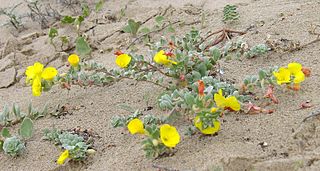
Camissoniopsis cheiranthifolia, the beach suncup or beach evening primrose, is a species of the evening primrose family and is native to open dunes and sandy soils of coastal California, Baja California and Oregon.
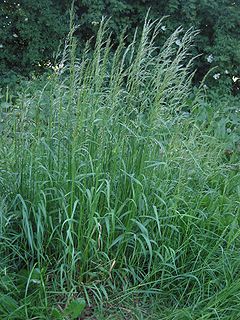
Arrhenatherum elatius, with the common names bulbous oat grass, false oat-grass, tall oat-grass, tall meadow oat, onion couch and tuber oat-grass, is a species of perennial grass, native to Europe, western Asia, and northern Africa.
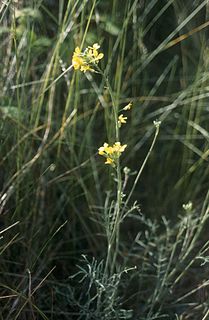
Coincya is a genus of flowering plant that belongs to the family Brassicaceae. Three species of the plant are endemic to the British Isles, these being Coincya wrightii, Coincya cheiranthos (nokkasinapit) and Coincya monensis, which has two subspecies, C. monensis subsp. monensis and C. monensis subsp. recurvata. Another four species are endangered and endemic to the south-central Iberian peninsula.
Coincya monensis subsp. recurvata, the star mustard or wallflower cabbage, is a subspecies of Coincya monensis.

Apodemia mormo langei, the Lange's metalmark butterfly, is an endangered North American butterfly. It is a subspecies of the Mormon metalmark and belongs to the family Riodinidae. The butterfly is endemic to California, where it is known from one strip of riverbank in the San Francisco Bay Area. A 2008 count estimated the total remaining population at 131 individuals. Since 2011, this number has dropped to about 25–30.
The Bonny Doon Ecological Reserve is a nature preserve of 552 acres (2.23 km2) in the Santa Cruz Mountains of California, United States. The reserve protects several rare and endangered plant and animal species within an area known as the Santa Cruz Sandhills, an ancient seabed containing fossilized marine animals.
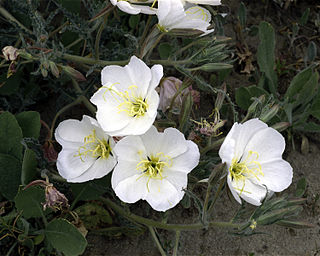
Oenothera deltoides subsp. howellii, the Antioch Dunes evening primrose, is an endangered subspecies of plant in the family Onagraceae, genus Oenothera, and species Oenothera deltoides.

Ophioglossum lusitanicum, the least adder's-tongue, is a small fern of the family Ophioglossaceae. It is a pan-tropically species categorised as least concern by the IUCN (2001).

The Eastern Isles are a group of twelve small uninhabited islands within the Isles of Scilly Area of Outstanding Natural Beauty, part of the Scilly Heritage Coast and a Site of Special Scientific Interest (SSSI) first designated in 1971 for its flora and fauna. They have a long period of occupation from the Bronze Age with cairns and entrance graves through to Iron Age field systems and a Roman shrine on Nornour. Before the 19th century, the islands were known by their Cornish name, which had also become the name of the largest island in the group after the submergence of the connecting lands.

Coincya monensis is a plant species in the family Brassicaceae. Coincya monensis is native to western Europe and Morocco, but has been introduced in North America.
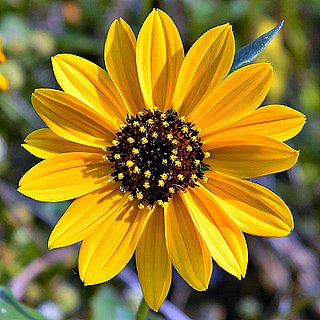
Helianthus debilis is a species of sunflower known by the common names cucumberleaf sunflower, beach sunflower, weak sunflower, and East Coast dune sunflower. It is native to the United States, where it can be found along the Atlantic and Gulf Coasts. It is known elsewhere as an introduced species, such as South Africa, Australia, Taiwan, Slovakia, and Cuba.
Coincya cintrana is a flowering plant of the family Brassicaceae. It is a hemicryptophyte plant, and it grows on walls, in steep areas and in rocky slopes. It flowers from April until June.

Persoonia terminalis, also known as the Torrington geebung, is a shrub belonging to the family Proteaceae, and native to northern New South Wales and southern Queensland in eastern Australia. Reported as a subspecies of Persoonia nutans in 1981, it was described as a species by Lawrie Johnson and his colleague Peter Weston in 1991.

Caladenia caesarea subsp. maritima, commonly known as the cape spider orchid, is a plant in the orchid family Orchidaceae and is endemic to the south-west of Western Australia. It has a single spreading, hairy leaf and up to three small mustard-coloured flowers with red stripes. It is only known from a small coastal area near Cape Leeuwin where it grows in clumps of ten or more.

Arctostaphylos glandulosa subsp. crassifolia is a rare perennial shrub, a subspecies of manzanita within the heather family commonly known as the Del Mar manzanita. It is narrowly endemic to the sandstone coastal terraces of San Diego County and northwestern Baja California. It is a burl-forming evergreen shrub typically found growing in a rambling habit on poor soils and hardpan. From December to February, white to pink urn-shaped flowers decorate its foliage, giving way to small fruits. It is listed as endangered and is threatened by land development, invasive species and modifications to the natural fire regime.
